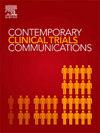A mixed-methods study on the recruitment of patients from ethnic minority groups to clinical trials in a central London teaching hospital
IF 1.4
Q4 MEDICINE, RESEARCH & EXPERIMENTAL
引用次数: 0
Abstract
Background/aims
Additional research is needed to fully understand barriers in recruitment to clinical trials and how these might affect different ethnic groups. The aim of this study was to explore the factors acting as barriers and facilitators in the process of recruiting patients to clinical trials in a UK (central London) teaching hospital, with a particular focus on patients from ethnic minority groups, and on areas where action could be taken.
Methods
The study was designed as a mixed-methods study comprised of: 1) a quantitative workstream which explored variations in the ethnic and gender breakdown of people admitted to hospital relative to the demographic characteristics of patients enrolled into research studies at the hospital, and 2) a qualitative workstream which explored staff experiences of recruiting patients to clinical trials and patients’ experiences of being approached to take part in a clinical trial. The quantitative workstream provided the necessary context for the design of the qualitative workstream.
Results
We found that the chances of being involved in research at the hospital were lower in all ethnic minority groups and lower amongst female patients. Some of the factors acting as barriers in trial participation included patients’ perceptions of clinical research as a form of experimental medicine that might have high risks, the role of family members in decision-making processes, and language barriers (where patients might not be fluent in English and the study information is not communicated in other languages). Potential strategies to address underrepresentation included the development of accessible information about research and how patient data are used, development of study materials in multiple languages and use of interpreters during the recruitment process, support for staff in involving family members in decision-making and a greater ethnic diversity within study teams.
Conclusions
The under-representation of people from minority ethnic populations in clinical research remains a major challenge, impacting on the rigour and applicability of findings as well as implying some populations are missing out on the benefits of research. Study design needs to place greater emphasis on patient need and convenience and therefore to take greater account of the deterrent effect of financial and time burdens on trial participants. Recruiting sites and sponsors need to review the provision of interpreting and translation support for trials, including availability and cost to individual studies and staff confidence in reliability.
伦敦中心教学医院临床试验招募少数民族患者的混合方法研究
背景/目的需要进一步的研究来充分了解临床试验招募的障碍以及这些障碍如何影响不同的种族群体。本研究的目的是探索在英国(伦敦市中心)教学医院招募患者进行临床试验的过程中作为障碍和促进因素的因素,特别关注少数民族患者,以及可以采取行动的领域。方法本研究设计为混合方法研究,包括:1)定量工作流程,探讨住院患者的种族和性别分类相对于在医院参加研究的患者的人口统计学特征的变化;2)定性工作流程,探讨工作人员招募患者参加临床试验的经历和患者被接触参加临床试验的经历。定量工作流程为定性工作流程的设计提供了必要的环境。结果我们发现,所有少数民族患者参与医院研究的机会都较低,女性患者的机会更低。参与试验的一些障碍因素包括患者认为临床研究是一种可能具有高风险的实验医学形式,家庭成员在决策过程中的作用,以及语言障碍(患者可能英语不流利,研究信息没有用其他语言交流)。解决代表性不足问题的潜在战略包括开发有关研究和如何使用患者数据的无障碍信息,开发多种语言的研究材料,在招聘过程中使用口译员,支持工作人员让家庭成员参与决策,以及在研究团队中增加种族多样性。结论:少数民族人群在临床研究中的代表性不足仍然是一个主要挑战,影响了研究结果的严谨性和适用性,也意味着一些人群错过了研究的好处。研究设计需要更加强调患者的需求和便利性,因此需要更多地考虑经济和时间负担对试验参与者的威慑作用。招募地点和赞助者需要审查为试验提供的口译和笔译支持,包括个别研究的可得性和费用以及工作人员对可靠性的信心。
本文章由计算机程序翻译,如有差异,请以英文原文为准。
求助全文
约1分钟内获得全文
求助全文
来源期刊

Contemporary Clinical Trials Communications
Pharmacology, Toxicology and Pharmaceutics-Pharmacology
CiteScore
2.70
自引率
6.70%
发文量
146
审稿时长
20 weeks
期刊介绍:
Contemporary Clinical Trials Communications is an international peer reviewed open access journal that publishes articles pertaining to all aspects of clinical trials, including, but not limited to, design, conduct, analysis, regulation and ethics. Manuscripts submitted should appeal to a readership drawn from a wide range of disciplines including medicine, life science, pharmaceutical science, biostatistics, epidemiology, computer science, management science, behavioral science, and bioethics. Contemporary Clinical Trials Communications is unique in that it is outside the confines of disease specifications, and it strives to increase the transparency of medical research and reduce publication bias by publishing scientifically valid original research findings irrespective of their perceived importance, significance or impact. Both randomized and non-randomized trials are within the scope of the Journal. Some common topics include trial design rationale and methods, operational methodologies and challenges, and positive and negative trial results. In addition to original research, the Journal also welcomes other types of communications including, but are not limited to, methodology reviews, perspectives and discussions. Through timely dissemination of advances in clinical trials, the goal of Contemporary Clinical Trials Communications is to serve as a platform to enhance the communication and collaboration within the global clinical trials community that ultimately advances this field of research for the benefit of patients.
 求助内容:
求助内容: 应助结果提醒方式:
应助结果提醒方式:


